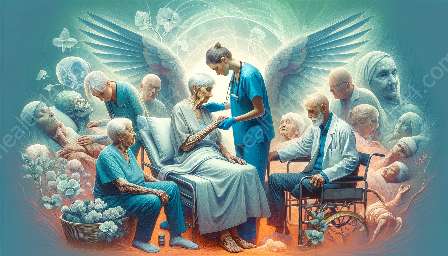As the elderly population grows, geriatric rehabilitation becomes increasingly important. Gait training plays a crucial role in helping elderly individuals maintain mobility, independence, and overall quality of life. This comprehensive topic cluster will explore the significance of gait training in geriatric rehabilitation and its compatibility with the field of geriatrics.
The Importance of Gait Training in Geriatrics
Gait training is a specialized form of physical therapy designed to improve a person's ability to walk safely and efficiently. In the context of geriatrics, gait training is particularly significant as it addresses the unique challenges faced by elderly individuals, such as balance issues, muscle weakness, and gait abnormalities.
Impact on Mobility and Independence
For elderly individuals, maintaining mobility and independence is vital for their overall well-being. Gait training can help improve their ability to walk, navigate their environment, and perform activities of daily living. By enhancing mobility, gait training contributes to a better quality of life for geriatric patients.
Reducing Fall Risk
Falls are a significant concern for older adults, often leading to serious injuries and a decline in overall health. Gait training focuses on improving balance, coordination, and strength, thereby reducing the risk of falls and associated complications. This proactive approach to fall prevention is especially important in geriatric rehabilitation.
Benefits of Gait Training in Geriatric Rehabilitation
Gait training offers a wide range of benefits for elderly individuals undergoing rehabilitation. These benefits extend beyond physical improvements and encompass psychological and social well-being.
Physical Improvements
- Strength and Endurance: Gait training helps improve muscle strength and endurance, enabling geriatric patients to engage in everyday activities with greater ease.
- Balance and Coordination: By focusing on balance exercises and gait retraining, gait training enhances the stability and coordination of elderly individuals.
- Pain Management: Proper gait mechanics can alleviate discomfort and pain associated with musculoskeletal issues, enhancing comfort and mobility.
Psychological and Social Well-Being
- Confidence and Independence: As geriatric patients make progress in their gait training, they often experience increased confidence and a sense of independence, leading to improved mental well-being.
- Social Engagement: Improved mobility and reduced fall risk can encourage elderly individuals to engage in social activities and interactions, fostering a sense of connection and belonging.
Integration with Geriatric Rehabilitation
In the context of geriatric rehabilitation, gait training is an integral component of comprehensive care for elderly patients. It is often incorporated into multidisciplinary rehabilitation programs tailored to address the specific needs of geriatric individuals, including physical, cognitive, and emotional aspects.
Individualized Treatment Plans
An individualized approach is essential in geriatric rehabilitation, and gait training is no exception. Rehabilitation professionals assess each patient's unique challenges and goals to create personalized gait training programs that address their specific needs and abilities.
Multidisciplinary Collaboration
Gait training in geriatric rehabilitation involves collaboration among various healthcare professionals, such as physical therapists, occupational therapists, and geriatric specialists. This interdisciplinary approach ensures that the gait training program meets the holistic needs of elderly patients.
Long-Term Management
Gait training in geriatric rehabilitation is not only aimed at short-term improvements but also focuses on long-term management. Comprehensive rehabilitation programs aim to equip elderly individuals with the skills and techniques to maintain mobility and prevent future issues related to gait and balance.
Techniques and Modalities in Gait Training
Gait training encompasses a variety of techniques and modalities tailored to the specific needs of geriatric patients. These may include:
- Walking Aids and Assistive Devices: Assessment and prescription of appropriate walking aids, such as canes, walkers, or specialized footwear, to support safe and efficient mobility.
- Balance and Coordination Exercises: Targeted exercises to improve balance, proprioception, and coordination, addressing common challenges faced by geriatric individuals.
- Gait Retraining: Rehabilitation professionals employ techniques to analyze and modify gait patterns, promoting proper alignment and functional walking mechanics.
- Functional Mobility Training: Integration of functional tasks and activities to enhance the practical application of improved gait and mobility skills in everyday life.
Future Directions and Innovations
The field of geriatric rehabilitation continues to evolve, with ongoing research and innovation shaping the future of gait training for elderly individuals. Promising developments include the integration of technology, such as wearable sensors and virtual reality, to enhance gait training outcomes and engagement.
Personalized Rehabilitation Technologies
Advancements in personalized rehabilitation technologies hold great potential for geriatric gait training. Customized interventions, such as tailored exercise programs and interactive feedback systems, have the capacity to optimize the effectiveness of gait training for elderly patients.
Community-Based Programs
Expanding access to community-based gait training programs can provide ongoing support and maintenance for geriatric individuals beyond traditional rehabilitation settings. By incorporating community resources and social support, these programs contribute to sustained mobility and well-being.
Conclusion
The role of gait training in geriatric rehabilitation is multifaceted and essential in promoting the mobility, independence, and overall quality of life of elderly individuals. Understanding the compatibility of gait training with the field of geriatrics underscores its significance in addressing the unique needs of aging populations. As the landscape of geriatric rehabilitation continues to evolve, the integration of gait training with innovative approaches holds great promise for enhancing the well-being of elderly individuals.


